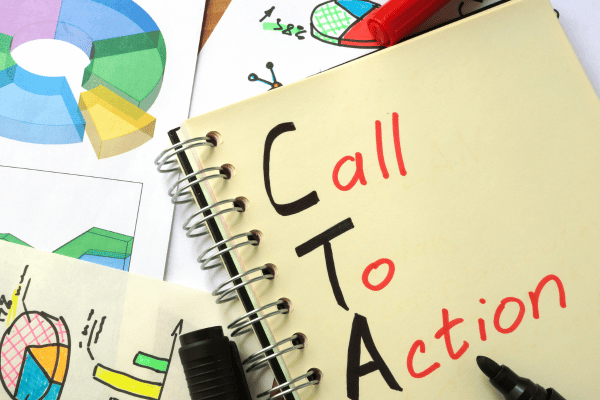
One common thing in all business types and sizes is that they all need to connect with their audience. In the good old days, companies relied heavily on direct interaction and offline marketing.
In today’s digital-first economy, most customer-to-business interactions occur online.
However, connecting with the target audience is just the beginning. Businesses must convince prospects to take the desired action to convert them into customers, and that’s where Call-to-Actions or CTAs come in.
These simple yet strategic instructions can be leveraged to encourage the target audience to perform actions useful to the business, from purchasing a product or service to reaching out for more information.
What is a CTA?
A Call-to-Action (CTA) is a prompt, direction, or request strategically positioned within a website or digital platform that is supposed to encourage a user to take a specific action. That action can be signing up to the website, signing up for a newsletter, making a purchase, downloading a resource, etc. Any piece of content, whether it’s a sentence at the end of a blog or a button in the middle of a web page that leads to the visitor taking the desired action (for which the CTA is placed), is called the CTA.
Why are CTAs Important?
CTAs are important for a number of reasons.
- A CTA that encourages a user to make a purchase or sign up for a paid subscription (initiating a transaction) is beneficial from a conversion optimization perspective. A good CTA (of this nature) may significantly enhance your conversion rate.
- A CTA that encourages visitors to sign up to your website to fully access it or access some of the tools to their full extent is beneficial because it converts visitors into users.
- CTAs that lead to visitors signing up for a newsletter or downloading a resource help your business establish itself as an authority on the subject and may improve your perception and reputation among the target market. It can also turn cold visitors into relatively warmer leads and passively increase your conversion rate.
To summarize, CTAs are important because they can convince at least a segment of your target market to take an action that benefits your business.
How to Create CTAs That Convert
Even though all CTAs clarify the action step for the visitor and encourage them to take action, the success rates vary drastically. Here are a few tactics that can help you create CTAs that actually convert:
1. Know Your Audience
Understanding your audience is not just important to write CTAs that convert; it’s crucial for essentially any successful marketing strategy or activity. From a CTA perspective, understanding who your audience is, their psychology, behavioral triggers that might prompt them into action, and what might appeal to them are some of the things that can help you create killer CTAs. It can help you write the right CTA message/content and design the CTA in an impactful way.
There are several layers of knowing your audience. The initial layers are tied to your products, services, regions you operate in, the socioeconomic status of your target audience, etc. You can use tools like Google Trends and Facebook Audience Insights in this phase. Understanding how your audience interacts with your website and which pages might have a better chance of converting them may require using tools like Google Analytics.
2. Develop Target Market Personas
Understanding your market as a whole is important, but so is dividing them into different segments and customer personas. Younger members of your target audience may not respond well to CTAs designed for an older, more mature audience. Similarly, some segments of your target audience may respond well to a discount CTA, while “good value” might appeal to others.
CTAs designed for specific customer personas are more likely to get traction than broader CTAs. They can also appeal to different demographics and can be event-driven. There are several free and paid digital marketing tools that allow you to create and manage different customer personas, including Semrush Persona and Hubspot’s Make My Persona (both free).
3. Keep it Simple
Remember that a CTA is a call, a directive, so don’t try to condense a sizable message in it. The simpler it is, the better. If it’s too complex or if there is a lack of clarity on what you want the customer to do or what’s in it for them, they may simply ignore it. You can use AI content creation tools like ChatGPT to help you write simple and effective CTAs. For design elements, you can use Canva or Visme.
4. Be Specific
A specific CTA that tells users exactly what it is they will be doing and how it might benefit them is likely to result in more conversions than a beautifully written and aesthetically pleasing CTA that might confuse them even a bit. So, always seek clarity in your CTAs.
5. Offer Incentives
One common element in most of the CTAs that convert is that they offer something to the user, whether it’s a limited-time deal, a newsletter that offers them useful information or keeps them apprised of any new deals or discounts that might be coming, or a useful resource.
6. Sense of Urgency
A sense of urgency (on its own) may be enough to encourage the website visitors to take action, but it’s far more effective when combined with an incentive. For example, if you offer a free resource with the message that it will become paid in a few weeks, it may prompt more visitors to download it than if it were free.
7. Design and Placement
It’s not just the message of the CTA that might encourage visitors to click on it, but its design and placement as well. You can use free graphics tools like Canva, Visme, or Figma for the design element of the CTA and can use templates and free resources. Test different placement configurations via A/B testing and keep the one (long-term) that shows the best results. You can use tools designed specifically for CTAs, like Wishpond’s CTA or Sniply, or use an A/B testing tool like VWO.
8. Emotional Appeal
Emotional appeal may not work for every business or at all times, but it should be leveraged whenever possible. Charities and other nonprofits can especially benefit from CTAs with adequate emotional appeal.
9. Humanize and Create A Sense of Belonging
Another thing you can do is humanize the message of your CTA, but it should be done with extreme care. Replacing “Sign Up” with “I am In” or “Press To Subscribe To The New Letter” with “I wish to be kept in the loop via your company’s newsletter” may lead to more conversions, but if you make the message too aggressive or casual, it may have the opposite effect. Similarly, creating a sense of belonging using words like family and community might improve their performance.
Final Words
When your goal is to create CTAs that convert, it’s also important to keep the larger context in mind. An impactful CTA might not get any conversion if the content before it causes readers to bounce before they reach the CTA. Similarly, just getting a customer to take action may not serve your broader business goals well, so you should evaluate its value in the context of the user funnel.


